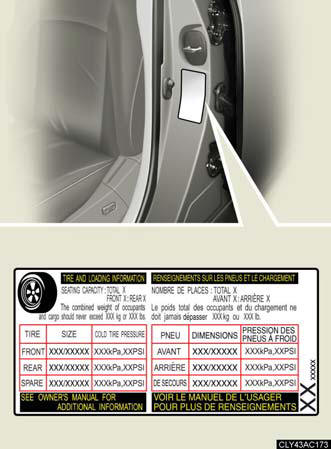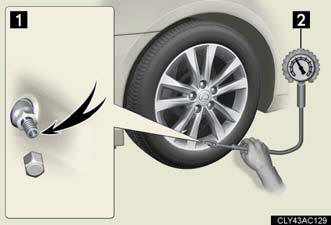Tire inflation pressure
Tire inflation pressure
The recommended cold tire inflation pressure and tire size is displayed on the tire and loading information label.

Inspection and adjustment procedure

1. Tire valve.
2. Tire pressure gauge.
1. Remove the tire valve cap.
2. Press the tip of the tire pressure gauge onto the tire valve.
3. Read the pressure using the graduations of the gauge.
4. If the tire inflation pressure is not within the recommended levels, adjust inflate the tire.
If you add too much air, press the center of the valve to lower.
5. After completing the tire inflation pressure measurement and adjustment, apply soapy water to the valve and check for leakage.
6. Reinstall the tire valve cap.
Tire inflation pressure check interval
You should check tire inflation pressure every two weeks, or at least once a month.
Do not forget to check the spare.
Effects of incorrect tire inflation pressure
Driving with incorrect tire inflation pressure may result in the following: - Reduced fuel efficiency.
- Reduced driving comfort and tire life.
- Reduced safety.
- Damage to the drive train.
If a tire needs frequent refilling, have it checked by your Lexus dealer.
Instructions for checking tire inflation pressure
When checking tire inflation pressure, observe the following: - Check only when the tires are cold.
If your vehicle has been parked for at least 3 hours and has not been driven for
more than 1 mile or 1.5 km, you will get an accurate cold tire inflation
pressure
reading.
- Always use a tire pressure gauge.
The appearance of the tire can be misleading. In addition, tire inflation
pressures
that are even just a few pounds off can degrade ride and handling.
- Do not bleed or reduce tire inflation pressure after driving. It is normal for
the
tire inflation pressure to be higher after driving.
- Never exceed the vehicle capacity weight.
Passengers and luggage weight should be placed so that the vehicle is balanced.
CAUTION:
Proper inflation is critical to save tire performance
Keep your tires properly inflated. Otherwise, the following conditions may occur
and result in an accident causing death or serious injury.
- Excessive wear.
- Uneven wear.
- Poor handling.
- Possibility of blowouts resulting from overheated tires.
- Poor sealing of the tire bead.
- Wheel deformation and/or tire separation.
- A greater possibility of tire damage from road hazards.
NOTICE:
When inspecting and adjusting tire inflation pressure
Be sure to reinstall the tire valve caps.
Without the valve caps, dirt or moisture could get into the valve and cause air
leakage,
which could result in an accident. If the caps have been lost, replace them as
soon as possible.
See also:
Engine/Transmission/Drivetrain/Performance
The IS 250's 2.5-liter V6 engine delivers 204 horsepower at 6,400 RPM and 185
lb.-ft. of peak torque at 4,800 rpm. The Lexus IS 350's 3.5-liter V6 offers a
more potent 306 horsepower at 6,400 RPM ...
Playing MP3 and WMA discs
- Type A
- Type B
- Type C
Selecting and scanning a folder
Selecting a folder one at a time
Press or
to select the desired folder.
Returning to the first folder
Press and hold until you ...
But does it go?
The ES 350′s V6 – shared with a handful of Toyota and Lexus products – has
become almost legendary for its refinement, if not its broad power range.
Silky-smooth at idle, its lack of intrusi ...
